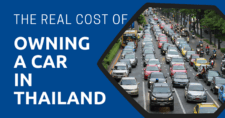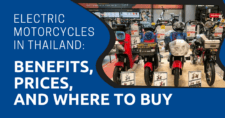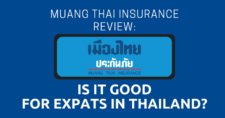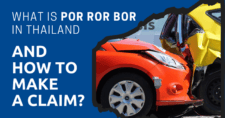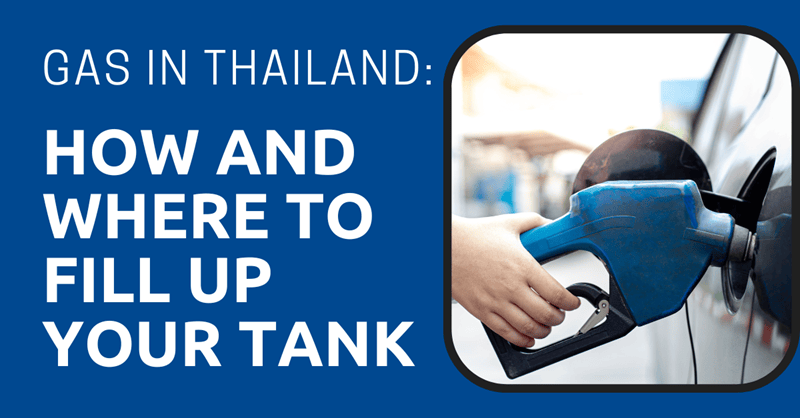
While driving in Thailand, you’ll notice that the country offers a lot more fuel options than, say, a place like the United States. And it can get quite confusing.
After all, what is the difference between E20 and E85? What’s B7? If you need standard diesel, which fuel should you ask for? And how can you tell if a gas station even carries your preferred fuel?
In this guide, you’re going to find out everything you need to know about filling up your tank in Thailand, including fuel options, which gas stations to choose, how to pay, how to check for the lowest gas prices, and some basic Thai phrases you can use the next time you’re at the pump.
"*" indicates required fields
Disclaimer: This article may include links to products or services offered by ExpatDen’s partners, which give us commissions when you click on them. Although this may influence how they appear in the text, we only recommend solutions that we would use in your situation. Read more in our Advertising Disclosure.
Contents
- Fuel Options
- Which Fuel Type Should You Choose?
- Gas Stations in Thailand
- Which Gas Brand Should You Choose?
- How to Fill Up Your Tank in Thailand
- Payment Options
- Membership Cards
- Best Credit Cards for Filling Up Your Tank
- Monitoring Fuel Prices
- What to Do if You Fill up with the Wrong Fuel?
- Filling Up With LPG
- Now, on to You
Fuel Options
There are two main types of fuel in Thailand: diesel and bensin. Both of these can be further categorized into different grades.
Diesel
| Diesel | 10% Biodiesel + 90% petrodiesel |
| Diesel B7 | 7% Biodiesel + 93% petrodiesel |
| Diesel B20 | 20% Biodiesel + 80% petrodiesel |
| Premium Diesel | B10 diesel that is enhanced to improve performance |
Bensin
| Gasohol E85 | 85% ethanol fuel + 15% gasoline |
| Gasohol E20 | 20% ethanol fuel + 80% gasoline |
| Gasohol 91 | 10% ethanol fuel + 90% gasoline. Gasohol 91 has an octane rating of 91. |
| Gasohol 95 | 10% ethanol fuel + 90% gasoline. Gasohol 95 has an octane rating of 95. |
| Bensin | 100% gasoline |
| Premium Bensin | Standard gasoline that is enhanced to improve performance |
Which Fuel Type Should You Choose?
Choosing the right fuel depends on your preference and vehicle type. For example, a car that runs on bensin would take E20 because it’s one of the cheapest fuels and many cars and motorcycles can run on it. But some people pick Gasohol 95, claiming it performs better than E20.
I normally use E20 for my car. Once in a while, I fill up with Gasohol 91 or 95 when I drive long distances because Gasohol 91 and 95 performs better.
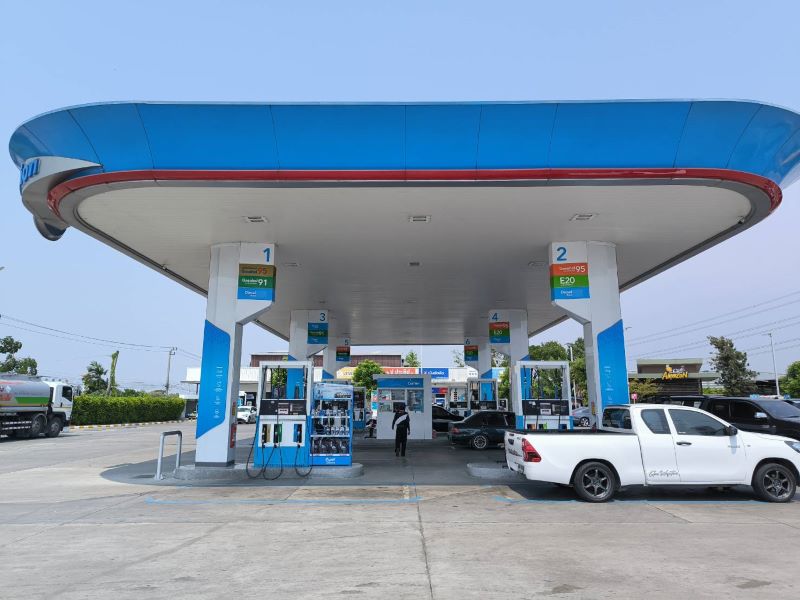
If you drive a diesel vehicle, you can fill it up with standard or premium diesel.
Not sure which type of gas to get? Check the sticker on the driver’s seat door. Most newer vehicles will have stickers that tell you which fuels you can use in the vehicle.
If you’re driving a rental car, ask the rental company which fuel type you should use.
Gas Stations in Thailand
You’ll find gas stations all across Thailand featuring both local and international fuel brands. Here’s a list of the various gas stations available in the country.
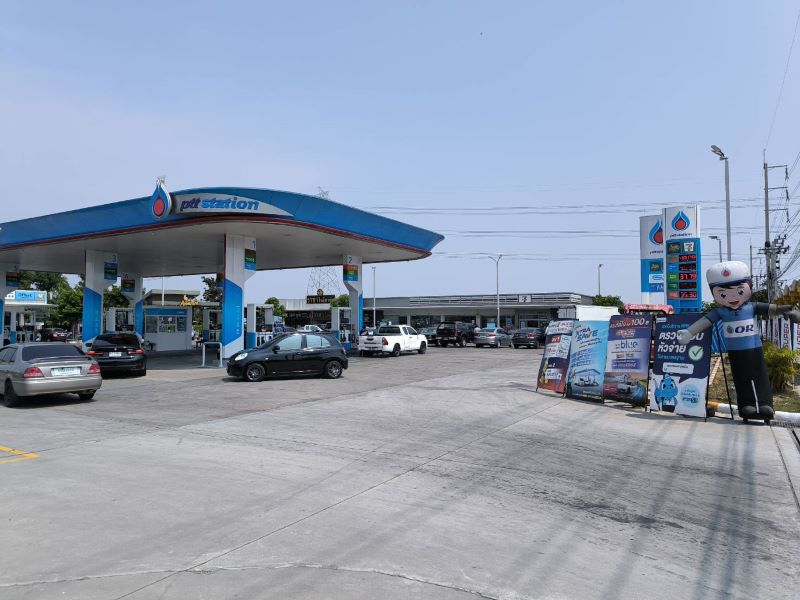
- PTT: This is the largest gas station chain in Thailand with the most branches. It’s located all throughout Thailand. PTT is especially popular with long-distance drivers because its gas stations have clean restrooms, restaurants, convenient stores, souvenir shops, and Cafe Amazon.
- Bang Chak: Bang Chak is another large gas station chain in Thailand. It further expanded its business after acquiring Esso, the well-known international gas station from France, in 2023. Bang Chak is known for its clean energy.
- PT: You can find PT all throughout Thailand as well. Since it’s not as popular as PTT and Bang Chak, you won’t wait as long to fill up your tank. PT is also known for its own coffee brand, Punthai Coffee — and it’s strong.
- Susco: Susco is the smallest gas station chain in Thailand. It’s located only in certain provinces.
- Shell: Shell is a British gas station company that has chains in Thailand. Since it’s a leading gas company, many people trust its gas quality. But gas prices from Shell are slightly more expensive than gas from other brands.
- Caltex: Caltex is another international company with chains in Thailand. It’s known for its gas quality. Some people claim that Caltex has the best gas in Thailand. But its gas prices are also more expensive than other companies.
Which Gas Brand Should You Choose?
In my case, I normally fill up my tank at Bang Chak because it’s simply the most convenient station for me to get to.
But when I drive to other provinces, PTT is my first choice. Not because of its gas quality, but because of its clean restrooms and convenient stores. Also, many PTT gas stations are safe, even at night. There are people coming and going all the time, and it’s well lit.
I also fill up the tank at other stations from time to time. But I haven’t noticed any difference in gas quality.
How to Fill Up Your Tank in Thailand
In Thailand, most gas stations offer full service. Just tell them which gas you need and how much, and the attendant will do the rest.
That said, it’s a good idea to learn basic Thai to make sure the attendant actually understands what you need and doesn’t put the wrong fuel type in.
Here is the speaking pattern used when asking for gas:
- fuel type + how much you want
For example, if you want a full tank of E20, you’d say “E20 Full” in Thai. If you only want 500 baht worth of gas, you’d say “E20 500 baht.”
And here’s a list of must-know Thai vocabulary for filling up your tank in Thailand.
| Vocabulary | Phonetic | Listen | Definition |
| E20 | E yêe sìb | Gasohol E20 | |
| 91 | gâao sìb èd | Gasohol 91 | |
| 95 | gâao sìb hâa | Gasohol 95 | |
| Diesel | Diesel | Diesel | |
| B7 | B jèd | Diesel B7 | |
| B7 ธรรมดา | B jèd tam ma daa | Normal Diesel B7 | |
| B7 พิเศษ | B jèd pí sèd | Premium Diesel B7 | |
| 200 บาท | sǒng róoi bàad | 200 baht | |
| 500 บาท | hâa róoi bàad | 500 baht | |
| 1000 บาท | nèung pan bàad | 1000 baht | |
| เต็มถัง | dtem tǎng | full gas tank | |
| ดีเซล เต็มถัง | Diesel dtem tǎng | Fill a full tank of diesel | |
| 95 เต็มถัง | gâao sìb hâa dtem tǎng | Fill a full tank of gasohol 95 | |
| E20 500 baht | E yêe sìb hâa róoi bàad | Fill up gasohol E20 for 500 baht | |
| สแกน | Scan | Scan a QR code for mobile payment |
Payment Options
You have three ways to pay for gas in Thailand.
- Cash: Mostly all gas stations in Thailand still accept paper cash.
- Credit and debit cards: Visa and MasterCard are accepted at most gas stations throughout Thailand.
- Banking app: If you have a Thai bank account, you can pay by scanning the QR code.
One important caveat when it comes to paying with a credit or debit card: some gas station attendants have been caught stealing people’s credit card numbers, expiration dates, and three-digit CVV numbers.
With this info, they can buy things online without you knowing. So, if you pay for gas with a debit or credit card at a lesser-known gas station in the countryside, it might be good to keep your card in sight at all times.
Membership Cards
All gas stations in Thailand offer membership cards that give you points every time you get gas. You can then use the points for discounts on gas or other shops like Amazon Cafe. But these membership cards aren’t available to expats.
Best Credit Cards for Filling Up Your Tank
Certain credit cards give you anywhere from 1 to 3 percent cashback every time you fill up your tank at a specific gas station.
As an expat in Thailand, your options are quite limited. But you can check out these two credit cards:
- Krungsri Signature Card: This card runs regular promotions with Bang Chak, giving you up to 3 percent cashback.
- Kasikorn Passion: While it’s not a credit card that offers cash-back benefits, you can quickly accumulate points with it. Then you can use the points to get discounts on gas later on.
Monitoring Fuel Prices
Fuel prices in Thailand change all the time. If you’re serious about getting the best price per liter, you can check out the following resources:
- แจ้งเตือนราคาน้ำมัน: When there’s a price change for gas in Thailand on any given day, the page lets you know at 6 p.m.
- Global Petrol Prices: Weekly updates for gas prices in Thailand.
- Motorist.co.th: Current fuel prices and yearly trends in Thailand.
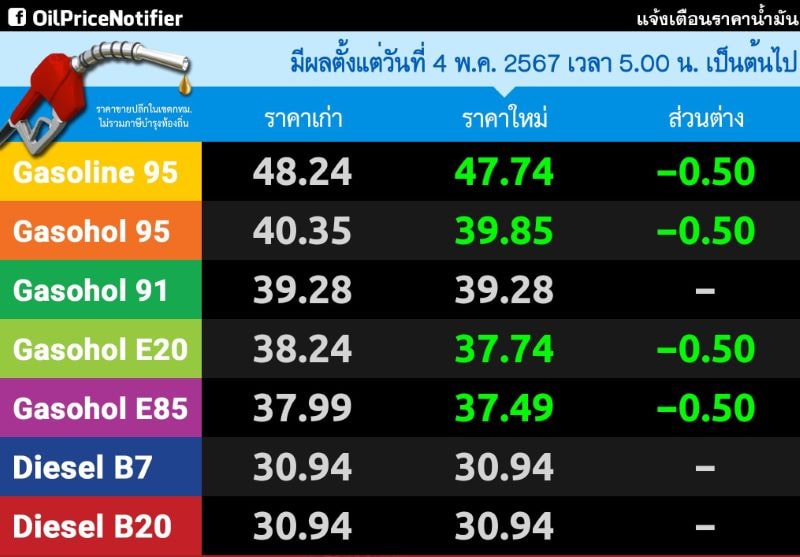
What to Do if You Fill up with the Wrong Fuel?
While it might seem impossible, filling up with the wrong gas happens to people from time to time. If you mistakenly put diesel in a gas car (and vice-versa) and try to drive away, you won’t get far. Your vehicle’s engine will begin to shake until it stalls.
Although it’s not dangerous, it can be scary. If this happens to you, do the following:
- Pull to the side of the road
- Immediately turn off the ignition
- Call a qualified mechanic
The mechanic may call a tow truck to bring your vehicle to the shop, or he will fill up a gas can with the right gas, run a temporary line to your engine, and then drive it to the shop.
Once your vehicle is at the shop, the mechanic will drain and clean your fuel system. If no damage was done, you can add the correct fuel type and drive as usual. If you damaged any part of your fuel system, he may have to change some parts.
If this happens in a rental car, contact the company and explain everything in detail. If it’s your own car, contact your insurance company. You might be able to make a claim if you have Type-1 insurnace.
Read more: Car Insurance in Thailand: A Complete Buying Guide
Filling Up With LPG
Because of increasing gas prices, many car owners in Thailand install Liquefied Petroleum Gas (LPG) systems in their cars. This way, their cars can run with LPG, which is almost 50 percent cheaper than gas.
When you need to fill up with LPG, you have to look for the right gas station. These gas stations will have a big LPG sign in front.
Of all the companies mentioned above, only PTT and PT have LPG gas stations in Thailand. But as of now, the number is quite limited.
Most of the time, you have to go to independently owned LPG gas stations, and standards vary. As a rule of thumb, you should only fill up your tank with LPG from a gas station with newer pumps.
Now, on to You
How often do you fill up your tank in Thailand? And do you have any tips or tricks for your fellow expats? Let us know in the comments section.


